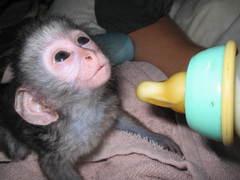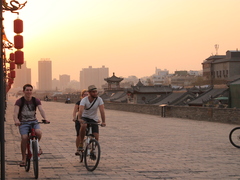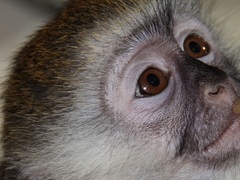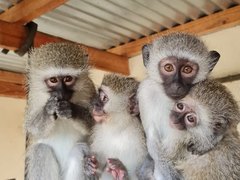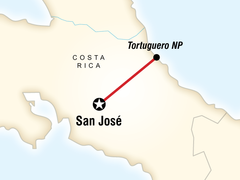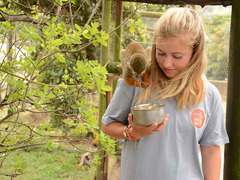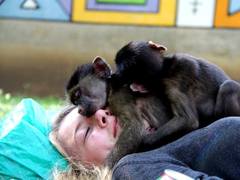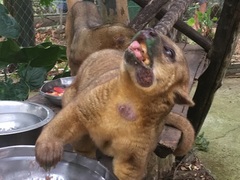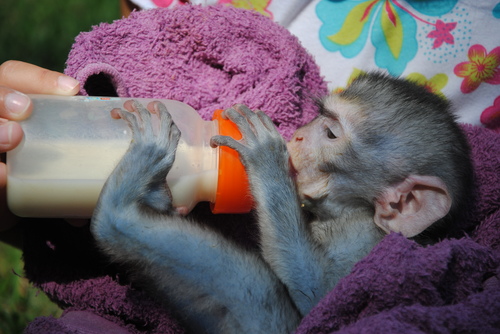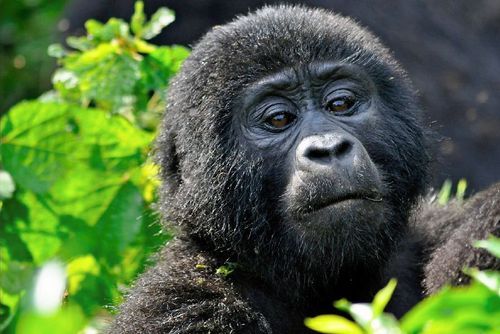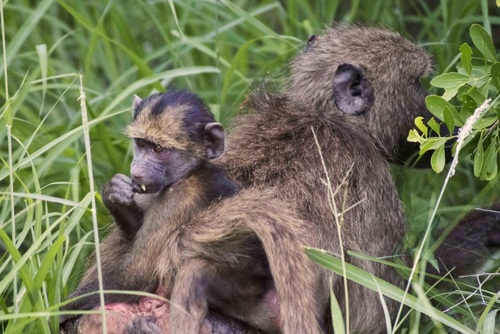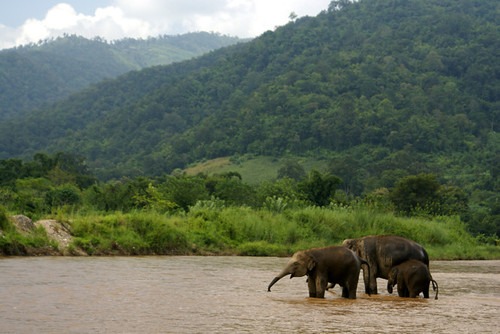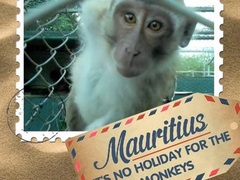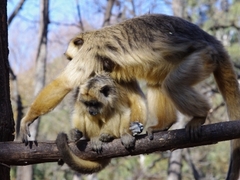The Spot is full of native flora and fauna. Crossed by the river, with arboreal plantations inhabited by 12 groups of monkeys whose howls are our alarm clock early in the morning. With strong seasonality, with bright sunny days and blue skies until cold days of snow.
The place is home to many animals and people who love them and enjoy taking care of them. A place where people can and should use all their skills and imagination to perform daily work and provide solutions. A place where personal interests should be left out.
Howler monkeys, capuchin monkeys, pumas, dogs, cats, llamas, goats and people who every day gives their life for them, appreciate every little helps. Throughout the year, pass through the place tourists and volunteers that help, enjoy and take in his heart and soul a little of this beautiful place.
Volunteer Information
The centre is located at around 80 km from Cordoba in the province of Cordoba. It is situated in Tiu Mayú (from the Quechua words "Tiu" - sand; "Mayú" - river). It occupies 360 hectares in mountains, rivers, waterfalls and forests at 1,350 meters above sea level. The region is 11 km away from the closest village of La Cumbre.
For over 20 years the centre has been working with howler monkeys or Carayá (Alouatta caraya), specie which inhabits the forests and jungles of Northeast Argentina but it is hunted to be sell as pet. Also, since 5 years working with capuchin monkeys (sapajus cay). It is the first and only centre for rehabilitation of primates in Argentina and the only one, which works to rehabilitate the howler monkey in the world.
The centre is a Non Government Organization; ACPM Zoo-Cba (Asociación para la Conservación, Protección y Mejoramiento del Jardín Zoológico de Córdoba) founded in 1985 recognized as such by the authorities but receives no financial support.
The program of the centre consists of various stages of physical, psychological and social rehabilitation; or "we teach the monkeys to be monkeys again". In the centre we work with orphan monkeys turned "mistakenly" into pets. All have been taken from their natural habitats to satisfy the pet trade and to be held as exhibits in zoos.
All the monkeys have come from voluntary hand-ins, seizures by the government, zoo’s etc from throughout the country. All have been pet monkeys. Unfortunately the pet trade still exists in South America and although howler monkeys are a protected species in Argentina, enforcement of this status is not effective. It is now listed in CITES (Convention on International Trade in Endangered Species) Appendix 2, as ‘vulnerable’. Continued hunting for the bush meat and pet trades and habitat destruction ensure that numbers in the wild are still declining rapidly.
The “Refugio Del Carayá” was the first place in Argentina where the Black Howler Monkeys bred successfully outside their native habitat. This species is considered worldwide “difficult to maintain in captivity” – generally it does not survive and/or reproduce in zoos. There are more than 100 monkeys, which live FREE in 12 sectors within the refuge. There are also a few monkeys that cannot live with other monkeys or prefer to be alone or with humans.
The Pet Trade
When a monkey is captured from the wild more animals are sacrificed than is required to satisfy the demand. The mother who normally carries the offspring is the first to be beaten down and killed in order to take the baby. However, the group’s social bonds are so strong that other monkeys which try to defend the female are also sacrificed. More animals are affected than those destined to be sold. From the capture until the final destination, at least 5 or 6 died either in the group or amongst the specimens captured.
Up until their final destination the captured babies are kept in precarious conditions. They are neglected, are badly fed, are stacked, etc., and those monkeys that do survive arrive in a terrible state (wounded, suffering from shock, dehydrated etc).
Just like a human baby, primate offspring suffer physically, mentally and emotionally. The people that acquire it as a ‘pet’ will generally treat it like a puppy – out of ignorance. Under these conditions the baby cannot survive. It can only survive if treated like a human baby. This in itself brings forth another problem, the “humanization of the animal” – they learn to behave and act like a human being.
Before the offspring was captured it was progressing through a transition period of physical and psychological development at the same time coining different aspects of socialization. This process interrupted means that monkeys which reach adulthood as a pet will have been transformed into socially inept animals, aggressive, depressed and having developed strange neurotic behaviors.
Black Howler Monkeys (Alouatta caraya)
The howler is the largest New World monkey (monkeys from South and Central America). These social primates live high in the trees of the rain forest of Southern Brazil, Northern Argentina, Paraguay and Bolivia. These monkeys are in decline due to a loss of habitat.
Adult male howlers are black to brown. Females and the young are lighter in colour (sandy yellow). Howlers grow to be about 2 to 4 feet (0.6 to 1.2m) tall and weigh from 8 to 22 pounds (3.5 to 10kg). They have a long prehensile tail which acts as a powerful fifth limb. The underneath of the tail – about 2/3 rds of the entire length – has a palm of bare skin which allows a firm grip. The tail also helps the monkey to balance as it moves and is wrapped around branches as security against falling.
Howlers have a short snout and wide-set round nostrils. Adult females usually have one baby at a time. They eat mostly leaves but occasionally supplement their diet with fruit and maggots. Their only predators in the wild (apart from humans) are large birds of prey.
They live in the tops of trees in organized groups of between 3 and 20 individuals. When they feel threatened or in difficulty, the group is reorganized and they defend themselves screaming, cutting tree branches or defecating on the intruder. The communication is crucial. All the members of the group are joined by a complicated communication system that includes gestures and sounds. The roar or hoarse howl makes them one of the noisiest animals in the world.
Volunteer Program Details
Some activities volunteers may do at the centre:
- Feeding and care of the monkeys
- Observation, study and data input of the free social groups
- Attention and care of the orphan monkeys
- Cleaning and maintenance of the areas in the centre
- Construction and repairs to the refuges and airways
- Assisting in the capture and handling of the monkeys
- Working in the tree plantation for the monkeys (only in wintertime)
- Washing the monkey plates
- Cleaning of the volunteer’s dormitories and toilets
- Care of other animals: beside the monkeys, there are also a number of domestic and other wild animals that we care for: dogs, cats, geese, horses, llamas, donkeys, sheep, ducks, and chickens.
Skills Required to Apply
- Love for animals and the desire to protect them.
- To possess no fear of animals, especially not of dogs, because there are plenty!
- It’s not necessary to be a university or high school student.
- Patience and dedication are required.
- Mandatory vaccinations are required: tetanus and rabies.
You should be in good health and have an average physical condition, because the work includes a lot of walking and carrying food. If you already had severe problems with your back before, the volunteer work in the centre is not recommendable for you.
Language
Spanish and English. A beginner’s course in Spanish will be useful and you can learn more during your stay. The volunteer coordinator, who will be working with you, is a fluent English speaker.
Centre offers
- Daily room and board. Food is prepared and served by the centre staff including breakfast (tea, mate cocido, bread and marmalade) and simple lunch and dinner. If you prefer to eat something that you particularly like, you can buy those things in town. At the Refugio you have a fridge to keep things and a small stove to heat food.
- The day the volunteer arrives to the centre receives a cup, a plate, and cutlery. All this things must be washed and cared by the volunteer and returned the day of his departure.
- Toilet and shower in an outhouse
- The water for the shower is heated by lighting a fire. Don’t worry, you will be shown how to do this! It is very quick and easy.
- It is not possible to use the washing machine at the main house. To wash your clothes there is a laundry in the nearest village, to where you can take your dirty clothes and go to an internet café etc, while your laundry is done. You can also wash your clothes by hand in the center
- Volunteer coordinator organizing all the activities (English speaker)
You will live in a very rustic environment. The toilet and shower are not located in the same place than the bedrooms. The shared rooms (2-3 persons per room) have power line electricity or solar panels providing electricity. You will need to bring a sleeping bag and be prepared to share the room with others.
The centre does not have urban comforts or luxuries. It is a really rustic area. There is no telephone or internet service in the centre. However, these are available in the La Cumbre, where you can go by taxi. We ask the volunteers to buy, once they are in Argentina, a Claro cell phone card, that card can be use on the volunteer coordinator’s phone in case you want to call a taxi to go to town.
If you want to bring a mobile phone, you can buy a local SIM-card to get the local nets. There is a bad net reception, but there are places, a little higher from the main house, where you can catch a mobile net.
Working Hours
The work of the centre takes place all year round, every day of the week. Caring for primates is from 9am to 6-8pm, more or less. Time off can be arranged depending on the number of volunteers with the volunteer coordinator in advance. Days off and half days off can be taken only one volunteer at the time (if it during working hours). After working hours you can go to town whenever you want to, alone or with other volunteers.
Paying
You will be expected to pay for the full duration of your stay on your first day of arrival. Payment should be made directly to Alejandra Juarez (the Project Manager). We suggest that you be prepared in advance, by bringing the payment in cash with you in the following currencies: Euros, American Dollars or Argentinean Pesos. Payment by credit card or checks or by any other means cannot be accepted. If you have any queries about this, please contact us (BEFORE arrival!)
Rates
- 2 week = 700 USD for person
- 3 week = 900 USD for person
- 1 month = 1000 USD for person
- 2 month = 1800 USD for person
- 3 month = 2000 USD for person
- For a stay longer than 3 months, you can make special arrangements with the volunteer coordinator.
Project Manager may offer to those volunteers who shown to be important to the project stay for longer without paying.
What to bring with you
- Sleeping Bag
- Rain Boots and rain coat
- Torch, lantern, flashlight
- Winter clothes from May to September. The rest of the year bring fresh cloth but also some coats (during the evening the weather is colder)
- Binoculars
- Personal items (personal hygiene products, toilet paper, towels, etc)
- Mountain footwear
- Hat
- Sunscreen
- Latex gloves and masks (like the ones used at hospitals). Monkeys can get a lot of diseases for being in contact with humans, so the only way to have contact with those monkeys that are still going through the rehabilitation program is using gloves and mask.
Dog Project
For the last months the centre has been running a dog shelter because of the amount of dogs living in the streets at La Cumbre. We already found families for over 30 dogs, but we still have other 50 trying to get a house! Working with the dogs includes: feed them, walk them across the field, change the water, clean the cages, build new shelters, assist the vet, try to get them new families, etc.
Notes
- If somebody you know (family, friends) wants to visit the centre, they have to pay the admission charge (ARG $100 for foreigner visitors, $50 for local visitors). They can only access to the same areas the regular visitors are allowed to go.
- Work materials and tools must be return to the storage place after used. If these things get lost because the neglect of the volunteer, he or she must replace them.
- Volunteers must keep rooms clean and in order. Dogs and cats cannot sleep inside the bedrooms. Beds are for human use only.
- The monkeys living free at the center cannot be touch under any condition. After the first week, the volunteer coordinator will determinate which monkeys in rehabilitation can be handle by you, before that you are not allowed to touch any monkey.
- During working hours you cannot use music players such as iPods, mp3 players, etc, or photo cameras. The work requires us to be focus


